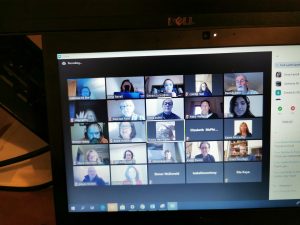4. Synchronous online teaching
“It can sometimes feel like you’re just talking to a screen as opposed to talking to people and you probably need to pedal a bit harder than you might in a classroom because nobody wants to leave long awkward pauses.” (Online Educator, Farrell et. al, 2019)
In the previous chapter we considered the importance of both student and educator presence in establishing a learning community in an online environment. In this chapter we will examine how the online classroom can be used to further develop the online course’s learning community. Online classroom technology allows an educator to hold synchronous, or real time, sessions with students. These sessions generally replace the face to face classes delivered in a traditional teaching approach. Online classes can be recorded, capturing audio, video, text chat, and content, for access and review by students who could not attend. Online classes are delivered using video conferening platforms such as Zoom, Microsoft Teams, and Blackboard Collaborate.

What does the literature say?
The major benefit of online synchronous classes for students is the opportunity to interact in real time with peers and to build a learning community (McBrian and Jones, 2009). Synchronous teaching can build teacher presence and student presence and humanize the experience of teaching and learning online (Martin, Ahlgrim-Delzell, Budhran, 2017).
In some ways the synchronous online classroom is essentially traditional face-to-face teaching “moved into a technological format with little change to the overall design principles” (Bates, 2019, p.159). This is described as an “old wine in new bottles” approach by Bates (2019), therefore it is important to design synchronous teaching that makes the most of the affordances of videoconferencing technology and that doesn’t just replicate the face to face environment. This can be done through using polls, breakout rooms and designing interactive online sessions, ensuring that activities that aren’t focused on passive content delivery are integrated into the online class.
Synchronous teaching during the Covid-19 Pandemic
During the Covid-19 pandemic, the majority of education shifted online and adopted some form of emergency remote education. Synchronous online teaching using videoconferencing tools such as Zoom and Microsoft Teams were widely used to support the emergency remote education (Bozkart, et. al., 2020). In the space of a year, teaching online moved from a niche to a mainstream activity. This massification of synchronous teaching and learning due to the pandemic has highlighted some challenges such as zoom fatigue, equity issues around camera usage, and access issues related to broadband and devices, and has shone a light on the importance of digital competencies for both educators and students to engage effectively in online education (Bozkart, et. al., 2020; Bali, 2020). Those who were immersed in online education prior to the pandemic, emphasised the differences between the emergency remote education which was adopted and a typical systematically designed online course. Online educators feared that the rushed unplanned online education delivered during the early months of the pandemic would tarnish the broad perceptions of online education.
“There was a lot of head shaking about emergency online learning, with many experts trying to “distance” quality online learning from emergency online learning” (Bates, 2021).
One of the earliest articles on this topic “The Difference Between Emergency Remote Teaching and Online Learning” coined the now ubiquitous phrase “emergency remote teaching”.
“Well-planned online learning experiences are meaningfully different from courses offered online in response to a crisis or disaster. Colleges and universities working to maintain instruction during the COVID-19 pandemic should understand those differences when evaluating this emergency remote teaching” (Hodges, Moore, Lockee, Trust, Bond, 2020).
In the post-pandemic era, it will be interesting to see which online practices and pedagogies are kept by educators and which are discarded and whether there will be a post-pandemic backlash for online education.
